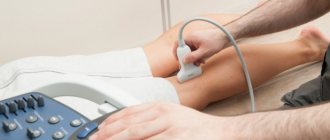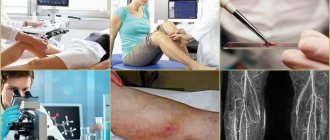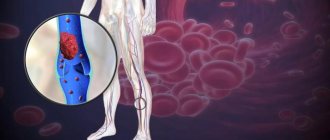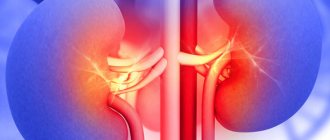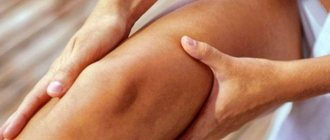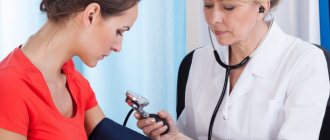Thrombosis - general concepts.
Thrombosis is the formation of blood clots in the lumen of a vessel; venous and arterial thrombosis are distinguished. Taking into account the topic of the site, we will talk about venous thrombosis.
Typically, the term thrombophlebitis refers to superficial vein thrombosis, and the terms thrombosis and phlebothrombosis refer to deep vein thrombosis.
Blood clots can form in any veins - veins of the upper and lower extremities, veins of the abdominal cavity, etc.
With deep vein thrombosis, there may also be a slight increase in temperature, increased venous pattern, etc.
Prevention
To prevent the formation of blood clots, blood thinning drugs are prescribed to patients with heart problems. Femoral vein thrombosis can also be prevented by regular general examination. A timely diagnosis of DVT can prevent many serious complications:
- thrombophlebitis with threat of sepsis;
- gangrene of the limbs and internal organs;
- infarction pneumonia as a result of thrombosis of the small branches of the pulmonary artery.
Do not take lightly the recommendations of doctors to take mild anticoagulants for varicose veins.
Nutrition
The substances we get from foods can affect blood thickness in different ways. In case of increased coagulability, in order to avoid the formation of blood clots, the following should be limited or completely eliminated from the diet:
- lard, fatty meat and sausages, canned meat, butter;
- white pastries;
- legumes (beans, peas, soybeans, lentils);
- rosehip, black currant, chokeberry;
- bananas and pomegranates;
- walnuts.
Useful foods for those with a tendency to develop blood clots include boiled lean meat, fish, cottage cheese and kefir, and vegetable oil. Fresh herbs (dill, parsley, onions), garlic, tomatoes are very useful. You can eat all fruits and berries except those that are prohibited. If the patient does not have diabetes and is not overweight, chocolate is allowed.
In addition to diet, it is very important to maintain a drinking regime. In addition to tea, coffee, juices, compotes and other drinks, you need to drink an average of about 2 liters of plain drinking water per day. A sufficient amount of fluid in the body can have a positive effect on blood viscosity, preventing blood clots from forming.
Treatment of thrombophlebitis of superficial veins.
The main therapeutic measures are reduced to elastic compression (elastic bandage or compression hosiery) and the prescription of medications.
Medicines used include phlebotropic drugs (detralex, phlebodia), antiplatelet agents (thrombo-ACC), and anti-inflammatory drugs (Voltaren). Lyoton-gel is applied topically.
All patients require venous ultrasound to exclude concomitant deep vein thrombosis and clarify the prevalence of superficial vein thrombophlebitis.
Possible complications
Of course, acute thrombophlebitis involves drug treatment; the sooner it is prescribed to the patient, the better for him. That is why timely medical consultation is important. As soon as you notice any manifestations of swollen veins, bluish discoloration of certain areas, or swelling and discomfort in the legs, it is important to immediately contact a vascular surgeon who will diagnose the patient and prescribe treatment.
If you do not pay attention to the manifestation of acute thrombophlebitis, the symptoms will only intensify, and the high temperature and severe pain will not allow the patient to live a full life. Movement will be limited due to severe pain and stiffness due to swelling and inflammation of the veins.
Treatment of thrombophlebitis cannot be delayed due to the risk of complications. The patient may develop trophic ulcers on the skin against the background of neglect or undertreatment of the disease. Thromboembolism and phlegmasia often develop; these conditions lead to gangrene of the lower limb.
The most difficult consequence is the detachment of a blood clot, which begins to move chaotically through the veins and vessels. Subsequently, the blood clot will adhere to the vascular wall, forming a blockage of the vein. This can lead to stagnation of blood and obstruction, or to rupture of the vein.
Any complication will be negative for the body and will affect health and well-being. There is a significant risk to the patient’s life, since acute thrombophlebitis in an advanced state can result in death or amputation of a limb. The risks are especially great when a patient develops acute deep vein thrombophlebitis; a blood clot can enter the bloodstream and in this case a high mortality rate is observed.
Treatment of deep vein thrombosis.
In almost all cases, deep vein thrombosis is treated in a hospital. An exception may be deep vein thrombosis of the leg, provided there is no threat of thromboembolism. The danger of thromboembolism can only be determined by ultrasound examination.
If deep vein thrombosis is suspected, the patient should be hospitalized immediately. In the hospital, an examination is carried out to clarify the prevalence of thrombosis, the degree of threat of pulmonary embolism, and treatment is started immediately.
Usually, drugs that reduce blood clotting (anticoagulants), antiplatelet agents, anti-inflammatory drugs, and phlebotropic agents are prescribed.
In case of massive thrombosis, in the early stages it is possible to carry out thrombolysis - the introduction of agents that “dissolve” thrombotic masses.
In case of recurrent thrombosis, a genetic study is carried out; if the tests are positive, the issue of lifelong prescription of anticoagulants is decided.
Laser treatment of varicose veins on the legs: price and reviews of the operation
For many unaware people, varicose veins are a purely cosmetic flaw, although in fact it is a vascular pathology, which in the future, without treatment, leads to serious consequences. And if a few decades ago varicose veins were treated purely surgically, today modern medicine has developed many conservative and minimally invasive treatment methods. For example, laser treatment of varicose veins, which is practiced in many medical centers and clinics.
Combating varicose veins of the lower extremities with laser is a painless, reliable and low-traumatic method that also eliminates cosmetic defects. The use of this technique guarantees the preservation of the results obtained for several years, preventing subsequent relapses of varicose veins. Another advantage of this treatment is short rehabilitation and minimal risks.
Indications for laser surgery
The main indication for the use of laser treatment is varicose veins of the small and large saphenous vein. And also, if the mouths of the vessels do not exceed a width of 1 cm, they assume a smooth course with slightly expanded or healthy branches. In connection with such indications, it can be understood that the laser procedure can be used at the initial stages of the development of varicose veins.
In addition, you need to know that the laser effect on the affected area can be small in area in order to prevent negative effects on nearby healthy tissue. In this regard, it is believed that laser is indicated for the treatment of varicose veins affecting a small number of vessels. For large affected areas, another treatment method, such as phlebectomy, is usually used.
Contraindications: who should not
Not every patient who has been diagnosed with varicose veins in the legs can be prescribed laser treatment by their doctor. In addition to cases where the laser may be ineffective and have a short-term effect, there is a list of strict contraindications for the procedure. All such warnings can be divided into two groups - categorical and relative contraindications.
The laser is strictly contraindicated for the following categories of persons:
- those who are predisposed to thrombophlebitis or thrombosis;
- those who suffer from chronic stage blood and lymph circulation disorders in the legs;
- those diagnosed with severe lesions of the venous walls.
In this case, the laser can cause severe thrombus formation or simply damage the walls of blood vessels. Also, if the patient is not able to be active in movements and does not have the opportunity to wear compression garments after treatment, laser therapy is contraindicated.
The following points are considered relative contraindications:
- inflammation of the skin of the legs;
- exacerbation of existing chronic diseases;
- period of pregnancy and lactation;
- overweight.
Otherwise, laser treatment can be a salvation from varicose veins, but before starting treatment you need to get approval from a phlebologist or vascular surgeon.
Advantages and disadvantages of the method
To assess the feasibility of treating varicose veins with a laser, you can familiarize yourself with the list of the main advantages of such a procedure. Compared to surgical intervention, the laser procedure has a huge list of advantageous differences, for example:
- Carrying out the procedure on an outpatient basis without the need to be admitted to a hospital;
- laser treatment is carried out under local anesthesia;
- no incisions or scars are implied, which means the laser allows you to achieve an excellent cosmetic effect;
- modern equipment does not leave behind scars, hematomas, swelling and bruises;
- During the procedure, both legs can be treated at once;
- the procedure involves short-term rehabilitation.
According to most medical specialists, laser coagulation of diseased vessels is the most effective, painless and safe way to treat varicose veins. The procedure takes 30-40 minutes, and an hour after completion of treatment the patient can go home. Despite this, laser treatment may also involve several negative aspects, namely:
- low effectiveness for advanced forms of varicose veins;
- if the diameter of the saphenous vein is above normal, laser treatment is combined with surgery, which means incisions will be required;
- You must wear compression garments for a week after treatment;
- cost of laser treatment for varicose veins.
Therefore, before deciding on laser treatment for varicose veins, you should carefully weigh the advantages and disadvantages of the procedure, indications and contraindications, and then additionally consult with your doctor.
Efficiency level
From a medical point of view, laser treatment is called endovasal laser coagulation; it is recognized as the most effective method of combating varicose veins. The purpose of the procedure is to glue excessively dilated vessels, as well as to give the lower extremities aesthetic appeal. Laser treatment, like sclerotherapy, involves first gluing the vessel and then completely resolving it. But in the case of a laser, there is no need to introduce chemicals.
How does the laser surgery itself work?
First, the patient will need to undergo an examination in the clinic, using duplex ultrasound to determine the presence of indications for laser treatment. Before starting the procedure, no preparation is required, except that you may take a sedative. To begin with, the specialist administers local anesthesia in the place where the puncture will be performed using special equipment.
Next, the specialist makes a small puncture into the skin of the leg, where the damaged vessel is located, into which a light guide with a connection to the laser is inserted. The equipment acts on the vessel by coagulation, after which the specialist removes the light guide out. The puncture must be disinfected with an antiseptic, applying a special bandage to protect against infections.
The duration of the procedure for one leg is 30-40 minutes, during the entire time the patient does not experience pain or discomfort. After completion, you need to lie in an upright position on the couch for some time, after which you need to carefully take a sitting position, then slowly stand up. Such measures prevent vascular collapse. For 7 days after this, the patient wears compression garments.
Possible consequences
Despite the minimal possibility of complications, the minimally invasive method of laser treatment, the absence of the need for general anesthesia, laser treatment may still involve consequences. If anesthesia is not administered correctly, the patient may experience painful symptoms and discomfort. Also, pain may manifest itself for some time in the area of the diseased veins.
Improper execution of the procedure can lead to injury to healthy leg tissue, burns, hematomas and swelling, and in the worst case, to inflammation and suppuration. Very rarely, laser treatment can provoke thrombosis and worsen the course of the disease. Signs of complications may include:
- increasing pain in the puncture area;
- increased temperature in the puncture area, redness and the appearance of purulent foci;
- feeling of heaviness, swelling and muscle pain when walking;
- general increase in body temperature;
- skin pigmentation;
- loss of sensitivity or paresthesia.
If at least one or more of the listed symptoms appear, the patient urgently needs to consult a phlebologist.
Rehabilitation
Since laser coagulation of blood vessels is a minimally invasive treatment method that does not require a hospital stay in the clinic, the patient can go home within an hour after the procedure.
After treatment, the specialist must give several recommendations regarding the prevention of recurrence of varicose veins:
- weight control;
- avoiding long periods of standing or sitting;
- rejection of bad habits;
- proper nutrition and drinking regime;
- wearing comfortable shoes made from natural materials;
- active pastime.
No other rehabilitation and recovery measures are provided after the laser procedure against varicose veins. The only condition for recovery after treatment should be wearing compression garments for a week.
Reviews about the treatment of varicose veins with laser
Cost of laser treatment for varicose veins
For many patients, the fact of how much laser treatment for varicose veins costs is daunting. In fact, the list of benefits of such treatment justifies the costs, since only laser coagulation with minimal effects on the skin guarantees such an effect. The treatment is accompanied by a minimal puncture, does not require general anesthesia or hospitalization, lasts only 40 minutes, and is not accompanied by rehabilitation.
The cost of laser coagulation of blood vessels for varicose veins can range from 28,000 to 40,000 rubles per procedure, it all depends on the pricing policy of the clinic, its location, the region of the country, the prestige of the specialists and the quality of the equipment used. The price is also determined by the use of modern equipment and the long-term results obtained.
Thrombosis in the superior vena cava system (veins of the upper extremities).
Occurs quite rarely. Almost never causes pulmonary embolism.
Causes of thrombosis in the superior vena cava system
– basically the same as other venous thromboses. It may also develop as a complication of venous catheterization (cubital, subclavian catheter), sometimes arising as a result of prolonged compression or uncomfortable position of the upper limb (for example, during sleep).
The most common is thrombosis of the axillary or subclavian vein (Paget-Schrötter syndrome). Within 24 hours, swelling of the entire upper limb occurs with cushion-like swelling of the hand. There may be slight bursting pain. The color of the limb is unchanged or slightly cyanotic.
Treatment of Paget-Schroetter syndrome
– the same as other venous thromboses.
Thrombosis of the superficial veins of the upper extremities.
Usually occurs after intravenous injections, taking blood from a vein. It is characterized by compaction along the vein, slight redness, and moderate pain.
Treatment usually does not require, but in case of severe symptoms, Lyoton-gel can be used topically and anti-inflammatory drugs (Nimesil, Voltaren, etc.) orally.
Forms and types
Thrombosis is distinguished by etiology, place of formation and types of blood clots:
- Proximal thrombosis is localized in the popliteal or femoral vein and causes pain in the leg, swelling and tenderness when palpating over the affected veins. But sometimes its first manifestation is pulmonary embolism.
- Distal thrombosis affects the calf veins. There is moderate pain and tenderness in the lower leg, but sometimes there are no symptoms. There is usually no swelling.
- Ileofemoral thrombosis occurs in the iliac and femoral vessels. Pain is felt along the inner thigh, calves, and groin. The leg swells noticeably from the foot to the groin. Palpation in the projection of the main veins of the thigh and groin is painful.
Thrombi often form in the femoral vein, somewhat less frequently in the popliteal and gastrocnemius, and in the inferior vena cava - relatively rarely.
By origin, thrombosis can be stagnant (with varicose veins, external compression of blood vessels, internal obstructions to blood flow), inflammatory and associated with thrombophilia.
There are also occlusive, parietal and floating thrombosis . A floating thrombus is diagnosed in approximately 10% of cases. It is attached to the venous wall at only one end and seems to dangle in its lumen, so the likelihood of tearing off is very high.
Treatment of thrombosis, venous thrombophlebitis - cost of services
Consultation with a phlebologist (candidate of medical sciences) (questioning, examination, prescribing examination and treatment) - 15,00 rubles
Ultrasound of the veins of the lower extremities - 2000 rubles
You can see a detailed route map.
Ascending thrombophlebitis is considered the most dangerous form of the disease; it is characterized by a rapid increase in the size of the blood clot. The pathological condition is accompanied by an inflammatory process in the saphenous vein, resulting in blockage of the venous lumen and a change in blood flow.
The cause of the disease is varicose veins. Acute thrombophlebitis is detected when the disease moves from the great saphenous vein to the inguinal folds. Symptoms include pain in the lower extremities, a feeling of fullness in the lower leg, and hyperemia of the skin over the affected blood vessel.
Patients often experience swelling of the legs, dense and painful cords, general malaise, and an increase in body temperature to 39 degrees or higher. The disease creates the preconditions for death, for this reason, at the first suspicion of an illness, you need to seek medical help.
Symptoms
Often, the symptoms of ascending thrombophlebitis are pronounced. For this reason, diagnosing this disease is not a difficult task.
The clinical picture is determined by the localization of the inflammatory process, its duration, and the scale of its spread. In addition, special attention is paid to the damage to muscle tissue adjacent to the site of the disease.
Taking into account all these symptoms, doctors determine the form of the disease - from minor inflammatory processes to clearly defined ones. The most risky manifestation is considered to be the manifestation of disease of the great saphenous veins.
With ascending thrombophlebitis of the saphenous vein, edema of the lower extremities does not occur, and the disease manifests itself as follows:
- when palpating the inflamed areas, a compaction is felt, and the patient experiences pain;
- skin temperature rises;
- the subcutaneous tissue is thickened and the skin has redness;
- while walking, the pain intensifies, a constant heaviness is felt in the legs;
- the patient complains of general malaise and weakness.
However, in the event of further spread of the inflammatory process through the blood vessels, damage occurs to large veins, namely the great saphenous, common femoral, and saphenofemoral anastomosis.
In such a situation, the symptoms will be quite pronounced. Swelling of the lower extremities occurs from the feet to the lower back, accompanied by heaviness and pain.
What is ascending thrombophlebitis?
When inflammation moves from the superficial vein to deeper ones, there is a risk of a blood clot breaking off and moving through the bloodstream. This phenomenon provokes pulmonary embolism. The thrombus moves from low-lying veins to the groin area and above.
The disease usually affects the blood vessels of the legs; approximately 85% of cases occur due to varicose veins. Depending on the stage and severity of varicose veins, the doctor determines the degree of thrombophlebitis.
Health problems develop as a result of the harmful effects of negative factors, the most common being increased blood clotting and slow blood flow.
Other reasons should be mentioned:
- habit of drinking large amounts of alcohol, bad habits;
- sedentary lifestyle;
- previous operations;
- oncological diseases;
- postpartum period.
In addition to the above, pathology occurs with long-term use of hormonal contraceptives and infectious diseases.
Ascending thrombophlebitis is divided based on the type of affected venous vessel. This may be deep vessel thrombosis, thrombophlebitis of the saphenous veins of the lower extremities.
The acute course of ascending thrombophlebitis of the saphenous vein, with timely diagnosis, responds well to treatment. As the disease worsens, the blood clot moves to the pulmonary or femoral artery.
Doctors say that some people are predisposed to developing ascending thrombophlebitis of the legs, and among them there is a fairly high probability of the disease. Thus, the risk group includes patients who for a long time have to:
- be on your feet;
- move little;
- lie in bed after surgery.
The diagnosis of thrombosis of the great saphenous vein is made to people with varicose veins, overweight, hyperhomocysteinemia, and antiphospholipid syndrome.
This group also includes people leading a sedentary lifestyle.
Causes and risk factors
Blood clots form if three groups of factors are present:
- The venous wall is damaged. Due to their location, the saphenous veins are often subject to mechanical stress, and if they have a thin wall, injury is more likely.
Sometimes there is a detrimental effect of doctors with an undesirable effect on the veins during operations, infusions of concentrated solutions such as glucose, or the installation of an intravenous catheter.
- Slowing blood circulation. This risk factor is relevant in cases of prolonged bed rest, compression of a vein by foreign objects, or crush injuries to the extremities. In addition, there are conditions in which blood circulation is impaired. For example, heart failure, in which the required volume of blood is not pumped, and congestion begins.
- Increased blood clotting. It can be congenital or acquired, arising after infectious diseases, problems in the hormonal system, after taking certain medications or cancer.
- The growth of a blood clot that has blocked a vessel can stop on its own or with treatment, and the swelling can go away. The clot shrinks and may completely or partially close the vein. With complete blockage, the blood flow decreases and the vessel becomes empty, while the likelihood that the clot will come off is minimal.
- The second option is characterized by ongoing inflammation. One end of the growing thrombus attaches to the vein, and the other is in the lumen, its condition becomes unstable.
Typically, vein swelling is non-microbial and is a consequence of damage to the vessel with the formation of a blood clot. But often purulent processes are added to thrombosis due to microorganisms present in the blood or outside. Then purulent thrombophlebitis is diagnosed.
In a combination of three conditions, a blood clot is formed and an edematous reaction of the vessel wall, after which the process develops in two ways:
As a result, even a weak impact can tear it off, then a complication begins - thromboembolism of the pulmonary artery (more about it), when the occlusion of the pulmonary vessels impairs breathing, which often ends in death.
If the clot remains stable, its growth is directed. Penetrating through the veins, it destroys the valves, provoking phlebothrombosis, which turns into chronic venous insufficiency. In almost all cases, problems occur with the great saphenous vein.
Acute type of disease
The acute course of ascending thrombophlebitis will become a dangerous complication of varicose veins. The condition is fraught with rapid growth of the inflammatory process into the deeper veins of the legs, the occurrence of a migrating blood clot, and pulmonary embolism.
The manifestation of the island-ascending form of thrombophlebitis will be general inflammatory symptoms. These include swelling, redness of the skin, pain in the legs, the appearance of infiltrates, lymphangitis, lymphadenitis.
With this diagnosis, the patient’s general body temperature rises, sometimes the thermometer shows 40 degrees, and weakness characteristic of fever begins. At the site of thrombosis of the venous vessel, an infiltrate with clear boundaries is palpated.
At the very beginning of the pathological process, thrombophlebitis affects only a small surface of the venous vessels. But at the same time, blood clots provoke:
- thickening of the walls of blood vessels;
- inflammation;
- pain when pressed.
The main symptoms will be swelling of the affected leg and slight changes in pigmentation. Without adequate treatment, the disease covers the great saphenous vein, and there is a possibility of damage to the deep femoral vein.
The danger of thrombosis is that it becomes a provoking factor for chronic venous insufficiency. If thrombosis of the saphenous vein worsens, there is an option for the disease to transform into a purulent form, which sooner or later will cause sepsis of the lower extremities. To suppress the infection, the introduction of an increased dosage of antibiotics is indicated.
In order to prevent the blood clot from breaking off and moving through the blood vessels, doctors bandage the area with inflammation.
This measure is temporary. Subsequent therapy is provided, the tactics of which are determined on an individual basis.
Acute form of leakage
Acute ascending thrombophlebitis is a complex consequence of varicose veins. This form of the disease carries the risk of death - a floating thrombus is observed in the vein, the disease quickly moves from the small saphenous vein to the deep vein of the thigh. This threatens to damage the pulmonary artery.
Acute thrombosis
Signs of an acute form of ascending thrombophlebitis:
- Symptoms, inflammation of the veins - swelling, redness, pain, hyperemia, lymphangitis, infiltrates of the affected veins of the lower extremities.
- Constant weakness, frequent feeling of malaise.
- Near the affected vein, the presence of infiltrate in the form of a cord is felt.
- Increased body temperature.
Treatment options
The first therapeutic measures aimed at eliminating health problems include reducing pain, reducing general tension in the area of the inflamed venous canal, and eliminating swelling of the legs.
The most effective method is surgical intervention; surgery will be the only way to achieve a 100% positive result. An intervention to eliminate this form of thrombophlebitis is called crossectomy.
The operation involves ligating and cutting off the great saphenous vein and its main tributaries. For manipulation, the surgeon makes a small incision in the groin area, and at the end of the procedure, cosmetic sutures are applied.
An option for surgery may be distal thrombectomy, in which:
- the clot is removed using a catheter;
- pass through the clot;
- lead beyond the lower limit.
In recent years, more extensive intervention has been practiced for varicose veins complicated by thrombophlebitis.
However, thrombophlebitis of the large artery can be treated using conservative methods. If only superficial vessels are affected, it is quite possible to do without surgery. The main condition is that treatment must be timely and carried out in full. In this case, the patient is recommended to undergo a course of treatment with the following means:
- anti-inflammatory;
- anticoagulants.
Part of the therapy will be the use of tightening bandages and compression stockings. Banding has a positive effect on the condition of the lower extremities and will become a preventive measure against blood clots.
Compression underwear is worn constantly; it must be selected taking into account the individual characteristics of the patient’s body and the severity of the disease. Products can be purchased in pharmacies and orthopedic salons.
When the acute form is stopped, treatment must be continued, the patient is prescribed a course of physiotherapeutic procedures. He will need to undergo treatment with a Sollux lamp, iontophoresis with heparin ointment, UHF therapy, and treatment with diametric currents.
During the first two months after treatment, fixation of the affected limbs with an elastic bandage and the use of phlebodynamic medications are indicated.
After the main treatment aimed at improving the patient’s condition, the key point will be the prevention of subsequent worsening of the disease. The patient should every day:
- drink your daily portion of water;
- take vitamin and mineral complexes;
- wear therapeutic knitwear.
Almost all patients will need to take anticoagulants on an ongoing basis. In some cases, the doctor gives recommendations regarding daily routine and lifestyle. It happens that with thrombophlebitis it is strictly forbidden to visit steam rooms, saunas, or take hot baths.
Reviews say that there are traditional methods of treating the disease. Despite their high efficiency, you should not get carried away with them. Alternative medicine recipes should be used as an auxiliary method and only after agreement with a phlebologist.
In half of the cases, untreated thrombosis provokes an exacerbation in the first three months, so it is important to treat therapy conscientiously. With proper treatment, the risks drop immediately to 5%.
Untreated phlebothrombosis can cause death in 10-20% of cases; with timely treatment, mortality is reduced by 10 times.
What should pregnant women and postpartum women/mothers with acute thrombosis do?
According to statistics, about a quarter of pregnant women and almost half of postpartum women experience various manifestations of hemorrhoidal disease, the most painful of which is acute thrombosis. Usually, postpartum women and especially pregnant women, in response to their complaints to the doctor, hear an offer to be patient. This approach is dictated by the fact that there are many contraindications to the use of the vast majority of medications in pregnant women, and surgical intervention is regarded by the medical community as a factor that can provoke childbirth or stop the process of breastfeeding. In practice, this means that regardless of the severity of the pain syndrome, sometimes very significant, women are forced to remain without any effective treatment. Pain due to thrombosis, in turn, can worsen the psychological state of pregnant or postpartum women and lead to undesirable consequences during childbirth (premature birth) or during breastfeeding (refusal to breastfeeding). Our clinic is a supporter of a personalized approach to the treatment of acute thrombosis in such women. If acute thrombosis categorically prevents the patient from living, it should be actively treated using the entire arsenal of means used in ordinary patients, but taking into account contraindications for medications. In pregnant women in the second and third trimesters, it is possible to perform an operation to remove a thrombosed node (Fig. 7), as well as in postpartum women and women in labor (Fig. 8). During pregnancy, there are some restrictions on the local and general anesthetic drugs that can be used. Specific medications should be selected jointly by both the coloproctologist and the obstetrician so as not to harm the fetus or newborn. The specialists of our Clinic have experience in treating both pregnant and postpartum women with manifestations of acute thrombosis of the hemorrhoid with very good results, reviews of which our patients leave on our website, among other things.
a) b)
Rice. 7. Acute thrombosis of the external hemorrhoid in a 38-week pregnant woman.
Before surgery, pain was rated 8 out of 10, immediately after surgery 3 out of 10.
a) appearance of a thrombosed external hemorrhoid with necrosis, b) appearance after removal of the thrombosed node.
a) b)
Rice. 8. a) acute thrombosis of the external hemorrhoid with severe swelling in the patient on the 5th day after birth, b) the patient’s condition on the 7th day after surgery. On the first day after surgery, pain decreased from 9 to 4 out of 10.
You can read about the treatment of other manifestations of hemorrhoidal disease in pregnant women and postpartum women in the section Hemorrhoids in pregnant women .
Methods for diagnosing and preventing the disease
Diagnosis of ascending thrombophlebitis helps to establish the presence of blood clots, their location, and the proximal border of the clot. Diagnostic measures include palpation, ultrasound,.
If compactions are detected in the venous canal, it is recommended to palpate in the proximal direction; a distant painful point is taken as the boundary of the thrombus, and not the infiltrate itself.
According to research, about 60% of cases of thrombophlebitis are recurrent. There is absolutely no guarantee that next time the disease will not become ascendant.
Ascending thrombophlebitis is considered a dangerous disease of the circulatory system. To get rid of it you will need to put in a lot of effort:
- time;
- money.
Therefore, it is important to carry out timely preventive measures to minimize the risk of developing a pathological process.
If a person is at risk or does not want a recurrence of the disease, he needs to listen to the recommendations of the phlebologist. You should lead an active lifestyle, systematically perform leg exercises, walk more, and engage in light sports.
Thrombosis of the great saphenous vein is the most common complication of varicose or postthrombophlebitic disease. At the first symptoms of thrombosis, the patient should immediately consult a doctor,
to receive a referral for emergency surgery.
Diagnostics
Diagnosing the disease is not difficult. From the first hours of its occurrence, it exhibits characteristic symptoms, characterized by pain, redness and thickening of the vein blocked by a blood clot. The acute form is characterized by a sharp, severe pain syndrome. The diagnosis of the disease is made after examination and collection of medical history.
Research methods are aimed at confirming the expected diagnosis, determining the location and size of the blood clot and assessing the risk of its rupture. For this, an ultrasound of the legs is often sufficient. To confirm the diagnosis, a color duplex ultrasound scan is performed.
In addition to clinical data, other methods for diagnosing the venous system can be used. Venography can detect thrombosis. Laboratory tests establish certain important blood clotting factors.
Differential diagnosis is carried out with other diseases that are manifested by skin inflammatory processes. This takes into account the fact that thrombophlebitis is not characterized by general intoxication, high leukocytosis with severe inflammation and high temperature.
How to detect thrombosis of the great saphenous vein of the legs
If we talk about the clinical picture, thrombosis occurs against the background of inflammation of surrounding tissues. Along the vein, a dense infiltrate may be palpated, the subcutaneous tissue is infiltrated, and the patient experiences sharp pain when walking. But with the help of palpation, a phlebologist cannot make an accurate diagnosis, so angiographic research methods are used.
If thrombosis of the great saphenous vein is localized above the middle third of the thigh, this can be considered an embolic disease. Additional research is being carried out to exclude the possibility of a thrombus passing beyond the saphenofemoral anastomosis.
Symptoms
Symptoms of the disease are often clearly presented and do not cause difficulties in diagnosis.
Common symptoms:
- The constant presence of a feeling of fullness in the thigh, lower leg;
- Feeling of heaviness;
- The skin along the length of the affected leg vein is red and inflamed;
- Pain in the lower leg, thigh, worsens with movement;
- Weakness, constant feeling of malaise;
- Increase in temperature.
Thrombosis and its manifestations
The clinical picture is determined by the condition of the saphenous vein, the location of blood clots, their number, and mobility. Importance is given to inflammation in the tissues of the lower extremities located near the damaged vein. Based on the symptoms and these factors, the disease is divided into types and forms. Ascending thrombophlebitis is often clearly presented along the vein and can appear in small areas. A disease that develops in the great saphenous vein is considered dangerous. There is a high probability of a blood clot moving into a deep vessel, for example, in the thigh area. There is a risk of pulmonary embolism.
With such vascular damage, swelling of the lower extremities rarely appears. To the touch, an infiltrate is felt along the affected area, resembling a dense cord, creating pain. When diagnosing, it is important to determine the presence of a blood clot in a vein and its exact location.
The disease is life-threatening, so it is important to seek medical help from a phlebologist in a timely manner. They will help cope with the disease and prevent complications in time.
Reasons for the development of the disease
As this disease develops, the subcutaneous venous system begins to significantly increase in volume, and the normal process of blood flow undergoes changes. Varicose veins of the great saphenous vein appear as a small tumor formation that is located along the entire back of the legs, starting from the upper border of the kneecap and ending with the Achilles tendon.
Varicose transformation of the tributaries of the great saphenous vein and its main bed occurs if several predisposing causes are found.
These include:
- heredity;
- obesity;
- Lifestyle;
- dyshormonal conditions;
- pregnancy period.
Let's consider the hereditary factor.
Among medical workers there is no clear argumentation of the influence of heredity on the development of varicose veins. In 25% of patients with a confirmed diagnosis, relatives also suffered from this pathology. Most likely, a disorder of the structure of connective tissue and the presence of concomitant diseases, such as hemorrhoids, flat feet, and hernia of the anterior abdominal wall, are inherited.
Studies conducted among ethnic Africans refute the hereditary factor in the appearance of deformation of the veins of the lower extremities. Residents who live in their homeland get sick no more than 0.5%. And migrants are affected by this disease in 10-20% of the total number.
How does excess body weight affect the occurrence of varicose veins?
Large body weight is a scientifically proven factor in the occurrence of varicose veins. This is especially noticeable in the female population at the age of menopause and reproductive status. If the body mass index exceeds 27 kg/m2 body, the risk of developing a pathological process increases by 30-35%.
In men, no such pattern was found.
Lifestyle influence.
Varicose transformation of the great saphenous vein is considered to be the price for upright posture. Among men and women whose work involves standing for long periods of time, the incidence of the disease is much higher than that observed in victims with sedentary work. There is a certain list of professions included in the risk group.
The most common ones include:
- surgeons;
- hairdressers;
- cooks;
- waiters;
- office workers;
- sellers.
Clothing has a great influence on the occurrence and severity of the disease. Tight underwear, tight trousers and corsets affect normal blood flow in the main venous vessels passing in the area of the inguinal folds and the anterior abdominal wall.
An increase in intra-abdominal pressure caused by an unbalanced diet and certain diseases (constipation) increases the risk of pathology several times.
Hormonal disorders.
An increased content of estrogens, progesterone and their analogues has a negative effect on the condition of the wall of the venous vessel, in which its tone is significantly reduced. Therefore, this reason, which causes varicose veins, comes to the fore. Hormonal contraceptives, hormone replacement therapy, and prevention of late metabolic disorders with hormone-containing drugs are used more and more often in modern life. And as a result, an increase in the incidence of vein deformation.
Let's consider pregnancy as one of the factors in the occurrence of the disease.
The state of pregnancy is the main predisposing factor in the occurrence of this pathology in women.
The main points that influence varicose veins are:
- significant increase in circulating blood volume;
- pressure of the enlarged uterus on the retroperitoneal veins;
- increased intra-abdominal pressure during labor.
The great saphenous and femoral vein is significantly expanded in diameter during the third trimester of pregnancy and does not always return to its original state after childbirth. This serves as an additional provocative factor for the development of the disease.
Changes during the transition to thrombophlebitis
Thrombophlebitis is an inflammatory process occurring in the inner wall of a vein. The resulting blood clots attach to the vascular wall. During the first 3-4 days, the developing blood clots are poorly retained on the wall, so they can break off and migrate along the bloodstream . If this does not happen, the blood clot becomes attached to the wall of the vessel, which provokes the development of an inflammatory reaction. The latter leads to the formation of new blood clots.
To the clinical picture of phlebothrombosis (swelling, pain, cyanosis of the skin) are added manifestations of thrombophlebitis (fever, increased local temperature, redness).
